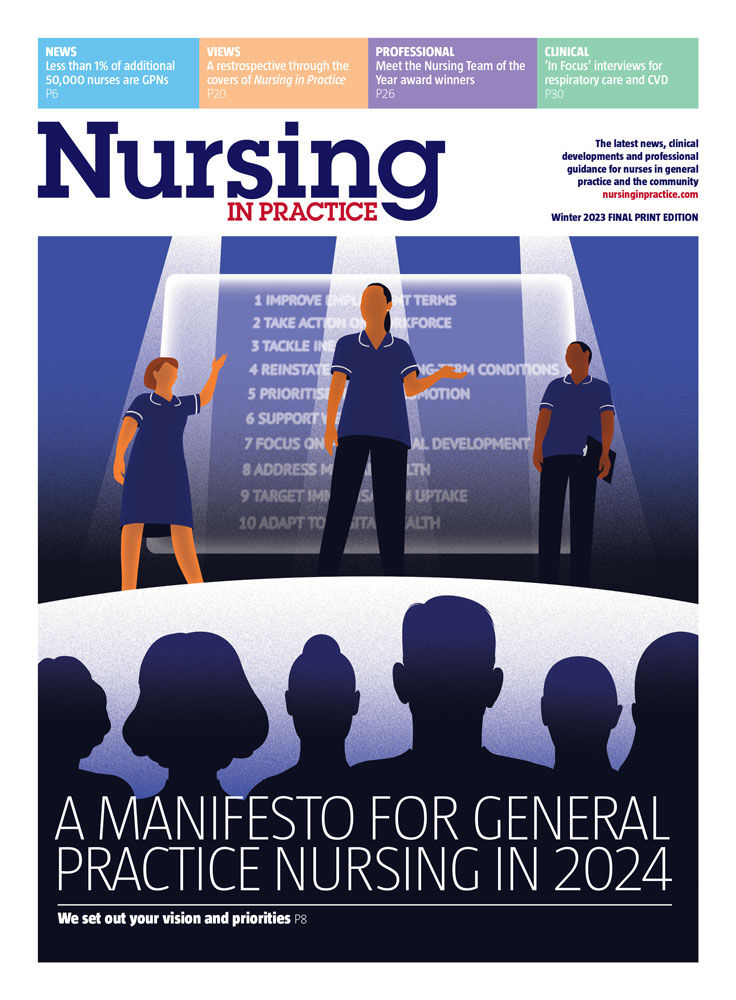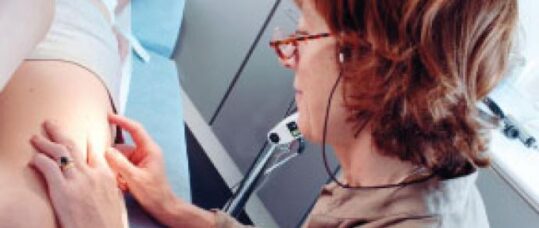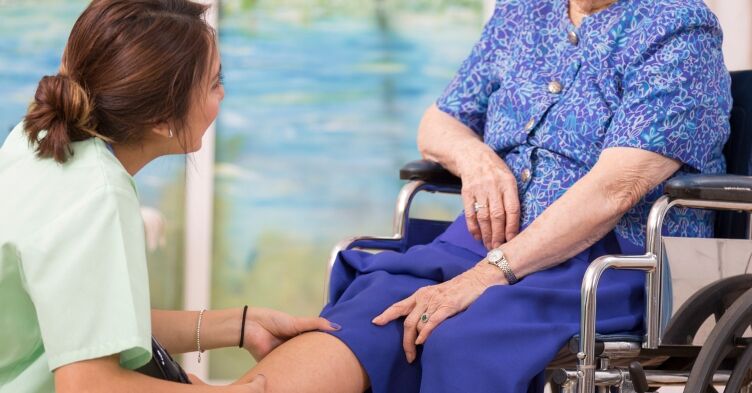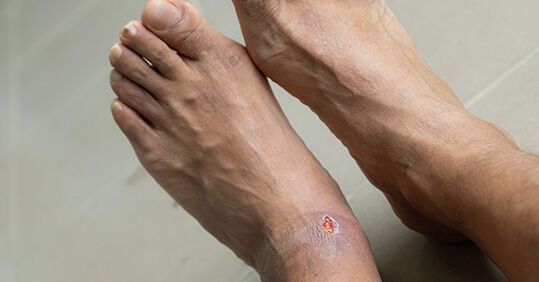Key skin assessment and language of dermatology learning points:
– A holistic skin assessment should include physical examination and individual assessment of psychological and social effects
– The language of dermatology is terminology that should be used when describing skin eruptions or lesions
– Touch is a critical component of skin assessment
Skin assessment should always be included in a holistic patient assessment. Primary care nurses observe and assess their patient’s skin on a daily basis. Patients will often ask primary care nurses about a rash or spot when they have concerns about their skin or have observed that their skin has changed. In dermatology, the word rash would describe a skin eruption and the word spot refers to a skin lesion. Primary care nurses should document any skin changes or concerns about new or existing skin lesions, and it is useful for them to know terminology used to describe skin changes.
This article provides an introduction to skin assessment and the language of dermatology, with the overall aim of helping primary care nurses to understand how to assess and describe what they observe on their patient’s skin.
Skin assessment
A skin assessment should consider the physical, psychological and social aspects of a skin condition or concern. A skin assessment should include the presenting concern/compliant with the skin, history of the presenting concern/compliant, past medical history, family history, social history, medicines (including topical treatment) and allergies and impact on quality of life.1 A nurse working in the community should conduct a skin assessment when the patient presents with a skin eruption on one or several parts of their body. Ideally, a skin assessment should also be conducted for patients concerned with skin lesions or moles, but this may not be practical in a primary care setting. In addition assessing pigmented lesions and screening for skin cancer requires specialist training, so patients should be referred to a GP.
A helpful acronym to remember the specific questions to ask patients when taking a skin history is ‘OLD CARTS’, which gives a systematic approach to questioning in a skin assessment, this includes onset, location, duration, character, aggravating factors, relieving factors, timing and severity.2
Skin examination is essential to inspect all areas of the skin from head to toe (including the nails, scalp, hair and mucous membranes).
At a dermatology appointment in secondary care, a full skin assessment involves the need for the patient to undress, so privacy and dignity is essential. However, chaperones will be required to examine genital areas. In primary care, this may not be practical as the patient may not be able to fully undress. In primary care, patients can partly undress and show areas of skin and questioning may be required for areas of the body that cannot be examined.
The principles of skin examination are:1
1.Inspect the skin – general observation, site and number of lesions and pattern of distribution.
2.Describe what you see on the skin.
3.Palpate the skin.
4.Include a systemic check.
Patient consent needs to be gained prior to a skin examination. The skin should be examined in a warm and private room with good natural light or artificial light, which does not change skin colour. It is important to touch the skin and never examine one lesion in isolation.
1. Inspect
The first stage of a skin examination is to inspect the skin. General observation is important to determine the pattern of distribution or configuration of either solitary lesions, or groups of lesions or large areas of skin eruption. For example, a rash covering a large area of the body would be described as a generalised eruption. However, a description may give more detail about a specific body area, for example a generalised eruption presenting on the lower legs and feet, but sparing the soles and nails. “A local or widespread eruption where lesions appear to be merging together is described as confluent, but it is also important to note areas where patterns of sparing appear.” For example, photosensitive disorders will only erupt in sun exposed areas.3 Symmetry can give useful diagnostic clues, for example symmetrical patterns are often seen in psoriasis, whereas fungal infections, such as tinea, are usually asymmetrical or unilateral.3 A generalist community nurse might spot these signs when patients ask questions about a skin concern or during routine patient assessment and nursing care.
Other descriptive terms for patterns of distribution include:4
– Acral – affecting distal areas, hands and feet.
– Extensor – extensor surfaces, elbows, knees.
– Flexural – flexural surfaces, axillae, genital areas, cubical fossa.
– Follicular – arising from hair follicles.
– Dermatomal – corresponding with nerve root distribution.
– Koebernised – arising in wound or scar.
– Seborrhoeic – associated with areas where there are sebaceous glands, face and scalp.
The pattern of individual skin lesions is also important to describe, they may be solitary, grouped or a satellite lesion with a clustered group surrounding.
2. Describe
The next stage in a skin examination is to describe the individual lesion or lesions, which are also referred to as primary lesions. SCAM is a useful tool to help remember the four stages in describing what you see on the skin:1
– Size and shape.
– Colour.
– Associated secondary change.
– Morphology and margin.
If a community nurse notices changes in any of these they should document them in the patient record and refer to the GP for diagnosis.
Size and shape
Size and shape helps describe individual lesions more accurately. Size should be measured by the diameter of the lesion as a useful clinical record, which can be used for comparison in assessing whether a lesion grows or regresses. This information should be recorded in the patient record and the patient’s GP informed. Terms that can be used to describe the shape of lesions include:3
– Annular – open circles.
– Discoid (or nummular) – filled circle.
– Arculate – incomplete circles.
– Recticulate – fine lace-like pattern.
– Stellate – star shaped.
– Digitate – finger shaped.
– Linear – straight line.
– Serpiginos – snake-like.
– Whorled – swirling pattern.
Colour
Normal skin colour is due to melanin, haemaglobin and carotenoids. The range of skin colours seen in skin conditions and individual lesions can be additional important diagnostic signs.
A nurse working in the community may spot colour change in the course of general patient assessment or during an episode of nursing care. Some common colour changes that should be noted when assessing the skin are listed in Table 1.
Secondary changes refer to epidermal changes on the surface of the skin in association with an eruption or lesion. These are addition signs and symptoms, which evolve from primary lesions and include scaling, crusting, excoriation, fissuring lichenificaion on the epidermis. Secondary changes may cause undulation, such as hypertrophy and keloids.4
Morphology describes the form and structure of skin lesions, using the terminology above. If a skin lesion has suspicious morphology and is pigmented it is important to additional assess for signs of skin cancer by inspecting the morphology and applying the ABCD-Easy guide5 should be applied:
– Asymmetry.
– Border.
– Colour.
– Diameter.
– Expert opinion.
3. Palpate
Touch is a very important tool in skin assessment. The palpation of eruptions of skin lesions will give additional information on the texture of the skin surface, consistency, thickness, mobility, tenderness and temperature.1 The methods for examination by touch in dermatology are:3
– Simple palpitation – to determine texture, tenderness and temperature.
– Blunt pressure – to detect oedema and assess capillary refill.
– Linear or shearing pressure – to elect dermographism.
– Squeezing or pinching – to gently determine consistency and mobility.
– Stretching – to detect blanching.
– Rubbing – to release chemicals and assess skin flare or wheals.
– Scratching or picking – to reduce scale or crust to assess extent of lesion.
4. Systemic check
A systemic check should be included with general medical history, medication and allergies.1 A systematic check in a holistic assessment should include assessment of psychological and social aspects by the individual patient.
Psychological and social assessment
A holistic skin assessment should always include a psychological and social assessment. This is essential as psychological distress is reported as a percipient or exacerbating factor in skin disease and a major determining factor in treatment outcome.6 Skin conditions also have a detrimental effect on the individual’s lives and quality of life, including affecting relationships, work, social functioning, hobbies and sports.6
There are a number of psycho-social assessment tools that can help the healthcare professional understand if a skin condition has a detrimental effect on a person. The Department of Dermatology of Cardiff University has played a major role in the development and validation of quality of life measures for use in dermatology. The dermatology life quality index (DLQI) was developed in 1994. It is a ’10-question validated questionnaire that has been used in over 40 different skin conditions’.7 The DLQI consists of 10 questions about physical symptoms, embarrassment, interference with shopping, home/garden, clothes, social/leisure activities, working/studying, relationships (and sexual difficulties); and managing treatment.7 The DLQI has also been adapted for infants and children (with a child-friendly cartoon version). For further information on copies and permission to use DLQI assessments see Resource section. The DLQI can be used in the community when a patient is distressed by their skin condition, due to physical symptoms (such as intense itching, scaling or uncontrolled flares) and psycho-social aspects such as embarrassment and difficulties with work and social life, due to their skin condition.
The charity Changing Faces (see Resources section) has recently developed a tool to help raise awareness of the psycho-social needs of patients with skin conditions.8 This is a simple tool, which suggests asking three questions, to assess psycho-social needs within a skin assessment:
1.It is not unusual for people to experience distress with a change in appearance. Have you experienced anything like this?
2.How does your condition affect your life on a day-to-day basis?
3.What are your coping strategies?
Conclusion
Understanding how to assess skin and learning the ‘language of dermatology’ are skills primary care nurses can develop. A comprehensive holistic skin assessment is essential for identifying skin changes that may result in an early diagnosis for a patient with a skin concern or condition. Developing skills in skin assessment will also ensure that a patient is appropriately referred for diagnosis, investigation and treatment.
Resources
The Department of Dermatology of Cardiff University’s development and validation of quality of life assessment–
cardiff.ac.uk/dermatology/quality-of-life
Changing Faces–
References
1. Chiang NY, Verbov J. Handbook of Dermatology for medical students and junior doctors (2nd edition). London: BAD 2014.
2. Ersser SJ. Assessment and Planning Care. In: Ersser SJ and Penzer R (eds). Principles of Skin Care. Chapter 3. Oxford: Wiley Blackwell, 2010
3. Cox NH, Coulson IH. Diagnosis of skin disease. In: Burns T, Breathnach S, Cox N, Griffiths C (eds). Rook’s Textbook of Dermatology (8th edition) Chapter 5. Oxford: Wiley Blackwell.
4. DermNet NZ. Terminology in Dermatology. dermnetnz.org/terminology.html (accessed 11 December 2015).
5. British Association for Dermatologists. ABCDEasy guide to checking moles. bd.org.uk (accessed 11 December 2015).
6. Bewley A, Affleck A, Bundy C et al. Working Party Report on Minimum Standards for Psychodermatology services. London: BAD, 2012.
7. Finlay AY, Khan GK. Dermatology Life Quality Index (DLQI): a simple practical measure for routine clinical use. Clinical Experimental Dermatology 1994;19:210-216.
8. Changing Faces. Meeting the psyhco-social needs of patients with skin conditions. London: Changing faces, 2015.








